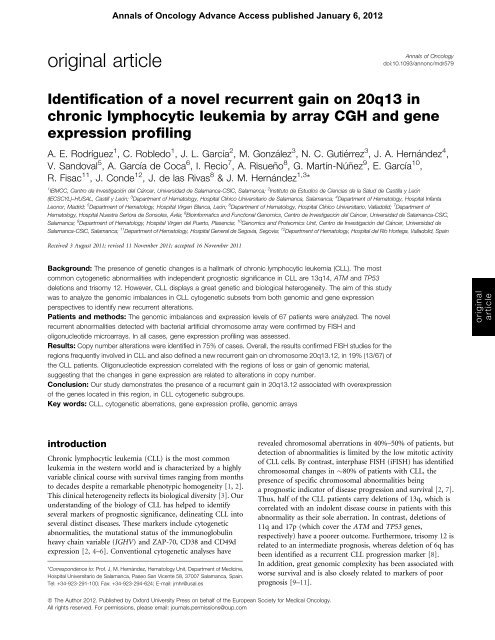Alberto Risueño Pérez - Gredos - Universidad de Salamanca
Alberto Risueño Pérez - Gredos - Universidad de Salamanca
Alberto Risueño Pérez - Gredos - Universidad de Salamanca
You also want an ePaper? Increase the reach of your titles
YUMPU automatically turns print PDFs into web optimized ePapers that Google loves.
original article<br />
Annals of Oncology<br />
doi:10.1093/annonc/mdr579<br />
I<strong>de</strong>ntification of a novel recurrent gain on 20q13 in<br />
chronic lymphocytic leukemia by array CGH and gene<br />
expression profiling<br />
A. E. Rodríguez 1 , C. Robledo 1 , J. L. García 2 , M. González 3 , N. C. Gutiérrez 3 , J. A. Hernán<strong>de</strong>z 4 ,<br />
V. Sandoval 5 , A. García <strong>de</strong> Coca 6 , I. Recio 7 , A. <strong>Risueño</strong> 8 , G. Martín-Núñez 9 , E. García 10 ,<br />
R. Fisac 11 , J. Con<strong>de</strong> 12 , J. <strong>de</strong> las Rivas 8 & J. M. Hernán<strong>de</strong>z 1,3 *<br />
1 IBMCC, Centro <strong>de</strong> Investigacio´n <strong>de</strong>lCa´ncer, <strong>Universidad</strong> <strong>de</strong> <strong>Salamanca</strong>-CSIC, <strong>Salamanca</strong>; 2 Instituto <strong>de</strong> Estudios <strong>de</strong> Ciencias <strong>de</strong> la Salud <strong>de</strong> Castilla y Leo´n<br />
(IECSCYL)–HUSAL, Castill y Leo´n; 3 Department of Hematology, Hospital Clıńico Universitario <strong>de</strong> <strong>Salamanca</strong>, <strong>Salamanca</strong>; 4 Department of Hematology, Hospital Infanta<br />
Leonor, Madrid; 5 Department of Hematology, Hospital Virgen Blanca, Leo´n; 6 Department of Hematology, Hospital Clıńico Universitario, Valladolid; 7 Department of<br />
Hematology, Hospital Nuestra Sen˜ora <strong>de</strong> Sonsoles, A´vila; 8 Bioinformatics and Functional Genomics, Centro <strong>de</strong> Investigacio´n <strong>de</strong>lCa´ncer, <strong>Universidad</strong> <strong>de</strong> <strong>Salamanca</strong>-CSIC,<br />
<strong>Salamanca</strong>; 9 Department of Hematology, Hospital Virgen <strong>de</strong>l Puerto, Plasencia; 10 Genomics and Proteomics Unit, Centro <strong>de</strong> Investigacio´n <strong>de</strong>lCa´ncer, <strong>Universidad</strong> <strong>de</strong><br />
<strong>Salamanca</strong>-CSIC, <strong>Salamanca</strong>; 11 Department of Hematology, Hospital General <strong>de</strong> Segovia, Segovia; 12 Department of Hematology, Hospital <strong>de</strong>l Rıó Hortega, Valladolid, Spain<br />
Received 3 August 2011; revised 11 November 2011; accepted 16 November 2011<br />
Background: The presence of genetic changes is a hallmark of chronic lymphocytic leukemia (CLL). The most<br />
common cytogenetic abnormalities with in<strong>de</strong>pen<strong>de</strong>nt prognostic significance in CLL are 13q14, ATM and TP53<br />
<strong>de</strong>letions and trisomy 12. However, CLL displays a great genetic and biological heterogeneity. The aim of this study<br />
was to analyze the genomic imbalances in CLL cytogenetic subsets from both genomic and gene expression<br />
perspectives to i<strong>de</strong>ntify new recurrent alterations.<br />
Patients and methods: The genomic imbalances and expression levels of 67 patients were analyzed. The novel<br />
recurrent abnormalities <strong>de</strong>tected with bacterial artificial chromosome array were confirmed by FISH and<br />
oligonucleoti<strong>de</strong> microarrays. In all cases, gene expression profiling was assessed.<br />
Results: Copy number alterations were i<strong>de</strong>ntified in 75% of cases. Overall, the results confirmed FISH studies for the<br />
regions frequently involved in CLL and also <strong>de</strong>fined a new recurrent gain on chromosome 20q13.12, in 19% (13/67) of<br />
the CLL patients. Oligonucleoti<strong>de</strong> expression correlated with the regions of loss or gain of genomic material,<br />
suggesting that the changes in gene expression are related to alterations in copy number.<br />
Conclusion: Our study <strong>de</strong>monstrates the presence of a recurrent gain in 20q13.12 associated with overexpression<br />
of the genes located in this region, in CLL cytogenetic subgroups.<br />
Key words: CLL, cytogenetic aberrations, gene expression profile, genomic arrays<br />
introduction<br />
Annals of Oncology Advance Access published January 6, 2012<br />
Chronic lymphocytic leukemia (CLL) is the most common<br />
leukemia in the western world and is characterized by a highly<br />
variable clinical course with survival times ranging from months<br />
to <strong>de</strong>ca<strong>de</strong>s <strong>de</strong>spite a remarkable phenotypic homogeneity [1, 2].<br />
This clinical heterogeneity reflects its biological diversity [3]. Our<br />
un<strong>de</strong>rstanding of the biology of CLL has helped to i<strong>de</strong>ntify<br />
several markers of prognostic significance, <strong>de</strong>lineating CLL into<br />
several distinct diseases. These markers inclu<strong>de</strong> cytogenetic<br />
abnormalities, the mutational status of the immunoglobulin<br />
heavy chain variable (IGHV) and ZAP-70, CD38 and CD49d<br />
expression [2, 4–6]. Conventional cytogenetic analyses have<br />
*Correspon<strong>de</strong>nce to: Prof. J. M. Hernán<strong>de</strong>z, Hematology Unit, Department of Medicine,<br />
Hospital Universitario <strong>de</strong> <strong>Salamanca</strong>, Paseo San Vicente 58, 37007 <strong>Salamanca</strong>, Spain.<br />
Tel: +34-923-291-100; Fax: +34-923-294-624; E-mail: jmhr@usal.es<br />
ª The Author 2012. Published by Oxford University Press on behalf of the European Society for Medical Oncology.<br />
All rights reserved. For permissions, please email: journals.permissions@oup.com<br />
revealed chromosomal aberrations in 40%–50% of patients, but<br />
<strong>de</strong>tection of abnormalities is limited by the low mitotic activity<br />
of CLL cells. By contrast, interphase FISH (iFISH) has i<strong>de</strong>ntified<br />
chromosomal changes in 80% of patients with CLL, the<br />
presence of specific chromosomal abnormalities being<br />
a prognostic indicator of disease progression and survival [2, 7].<br />
Thus, half of the CLL patients carry <strong>de</strong>letions of 13q, which is<br />
correlated with an indolent disease course in patients with this<br />
abnormality as their sole aberration. In contrast, <strong>de</strong>letions of<br />
11q and 17p (which cover the ATM and TP53 genes,<br />
respectively) have a poorer outcome. Furthermore, trisomy 12 is<br />
related to an intermediate prognosis, whereas <strong>de</strong>letion of 6q has<br />
been i<strong>de</strong>ntified as a recurrent CLL progression marker [8].<br />
In addition, great genomic complexity has been associated with<br />
worse survival and is also closely related to markers of poor<br />
prognosis [9–11].<br />
original<br />
article
















